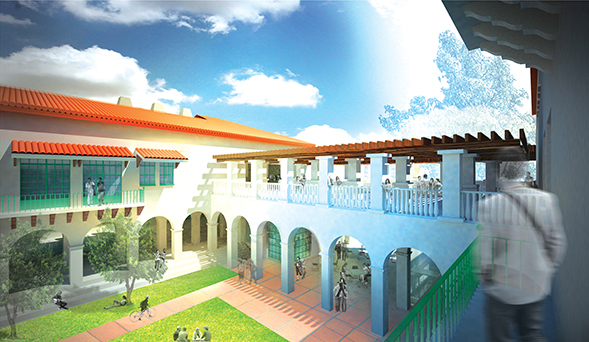Naming the Future
Donors lend their time, financial support and namesakes to the future of SDSU innovation.

San Diego State University’s Engineering and Interdisciplinary Sciences (EIS) Complex is a centerpiece of the university’s drive to become a top 50 public research university. The brand new complex, set to open in January, is built around the idea of fostering collaboration, with cutting-edge labs and equipment, plentiful shared workspaces and glass walls to inspire curiosity. The students, scientists and engineers who work there will be tasked with sharing their ideas with one another and seeking guidance from other fields to spur innovation. And none of this would be possible without the generous support of SDSU’s donors.“The potential for new ideas and for students and industry to come together to develop solutions to long-standing problems is thrilling.”
“With the development of the EIS Complex, we're asking donors to support our research vision,” said Mary Ruth Carleton, SDSU vice president for University Relations and Development. “We are putting our flag in the ground and saying, ‘We are a research university and we need people who believe in us to invest in that identity. Take a look at those who have made the investment; it is quite an impressive roster of alumni and friends.’”
Aztec connections
The names of many of those alumni and friends will grace spaces within the complex. So far, 22 spaces have been named for donors who are committed to inspiring the scientific and innovation leaders of the future. That’s what drove Alan Dulgeroff (’92), president of the SDSU Alumni Advisory Board, to give a gift naming the Alan M. Dulgeroff Engineering, Mentoring and Collaboration Connection (E=MC2).
Conveniently located across from the William E. Leonhard Entrepreneurial Center and the Mintz Levin Innovation Café—entrepreneurial spirit and caffeine being critical ingredients of innovation, after all—E=MC2 will be a bright, glass-filled space designed for industry mentors to share their practical, career knowledge with students and discuss design projects.
Dulgeroff graduated with an electrical engineering degree from SDSU, parlayed that experience into an internship with San Diego Gas and Electric, and has been working there ever since. He appreciates that SDSU has always provided a high-quality education grounded in regional workforce needs.
"My professors really took the time to mentor me and connect me with real-world problems to be solved in industry,” he said.
Within his own company, that’s reflected in the fact that about one in every ten employees is an Aztec. Dulgeroff continues that tradition through his own passion for mentoring and giving back, serving on the electrical engineering curriculum advisory board, and by encouraging SDSU alumni to give new graduates an opportunity to prove themselves through the Aztec Mentor Program and Aztecs Hiring Aztecs alumni initiatives.
“I wanted to memorialize the importance of giving students that real-world experience in the EIS Complex,” Dulgeroff said. “My hope is that the university and industry partners keep a close connection that helps mentor students, advises them, and allows them to work on technical problems relevant to the real world—and I hope a lot of that happens right in that room.”
Mind-blowing
Stephen Doyle (’80), president of San Diego–based builder and developer Sandy Point Properties, has been giving back to the university in some form since he graduated with a civil engineering degree. Besides his financial contributions, he serves on the College of Engineering Dean’s Advisory Board, helping to shape curriculum and mentoring experiences for students. He is excited to see how the EIS Complex will boost the opportunities for both students and industry partners to mutually benefit from the state-of-the-art technology and commitment to collaboration.“The things that are going to be going on in EIS are mind-blowing,” he said. “The potential for new ideas and for students and industry to come together to develop solutions to long-standing problems is thrilling.”
Although Doyle fondly remembers his education and experiences participating in surveying competitions, he knew even then the facilities weren’t exactly top-of-the-line. “I recall the labs were cold and institutional-looking,” he said.
When he learned about the EIS Complex, he wanted to be involved but wasn’t quite sure how best to commemorate the opportunities SDSU gave him as a student. Finally, an otherwise prosaic architectural feature caught his eye: the bridge connecting the old engineering building to the new EIS Complex.
The Stephen and Lynne Doyle Pedestrian Bridge serves as both a physical connection between two buildings and a metaphorical one between SDSU’s past and its potential. “For me, it’s the perfect solution,” Doyle said. “It bridges the old building, where I learned to be a civil engineer, to the future.”



